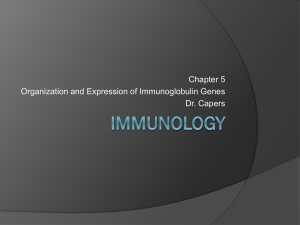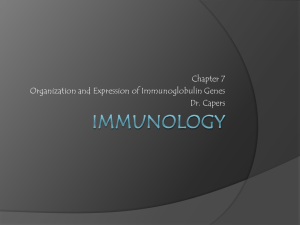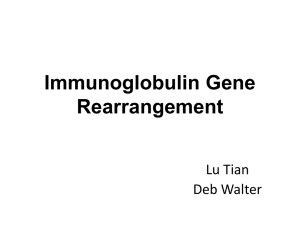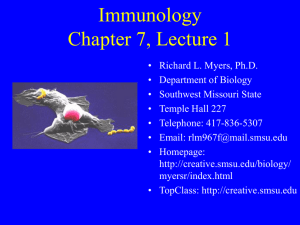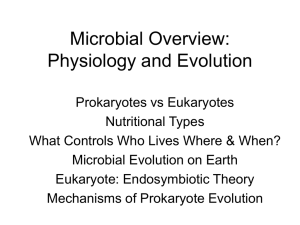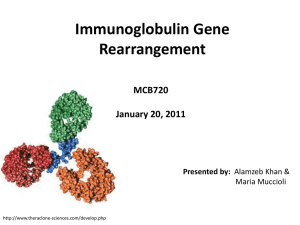Kuby Immunology 6/e
advertisement
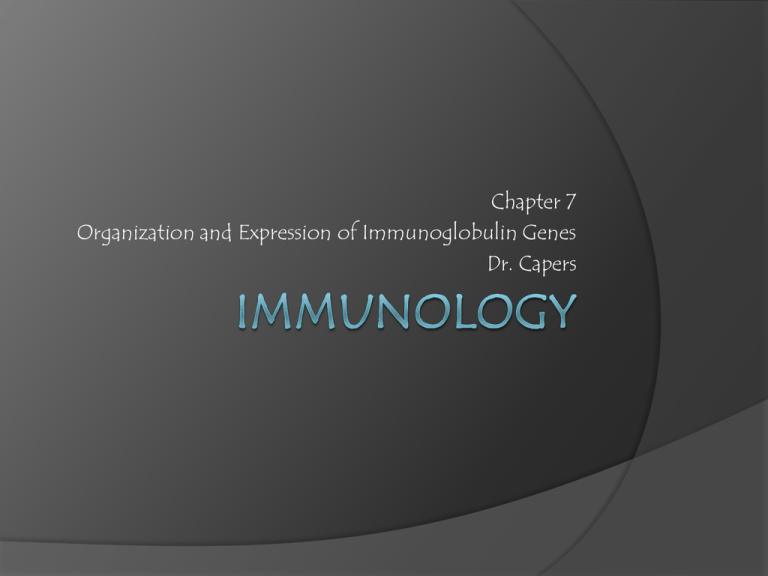
Chapter 7 Organization and Expression of Immunoglobulin Genes Dr. Capers Kindt • Goldsby • Osborne Kuby IMMUNOLOGY Sixth Edition Chapter 5 Organization and Expression of Immunoglobulin Genes Copyright © 2007 by W. H. Freeman and Company How does antibody diversity arise? What causes the difference in amino acid sequences? How can different heavy chain constant regions be associated with the same variable regions? In germ-line DNA, multiple gene segments code portions of single immunoglobulin heavy or light chain During B cell maturation and stimulation, gene segments are shuffled leaving coding sequence for only 1 functional heavy chain and light chain ○ Chromosomal DNA in mature B cells is not the same as germ-line DNA Dreyer and Bennett – 1965 2 separate genes encode single immunoglobulin heavy or light chain ○ 1 for the variable region Proposed there are hundreds or thousands of these ○ 1 for the constant region Proposed that there are only single copies of limited classes Greater complexity was revealed later Light chains and heavy chains (separate multi-gene families) are located on different chromosomes DNA rearrangement: produces variable region Later mRNA splicing: produces constant region Kappa (κ) and lamda (λ) light chain segments: ○ L – leader peptide, guides through ER ○V VJ segment codes for variable region ○J ○ C – constant region Heavy chain ○L ○V ○D ○J ○C VDJ segment codes for variable region Variable-region gene rearrangements Variable-region gene rearrangements occur during B-cell maturation in bone marrow ○ Heavy-chain variable region genes rearrange first ○ Then light-chain variable region ○ In the end, B cell contains single functional variable-region DNA sequence ○ Heavy chain rearrangement (“class switching”) happens after stimulation of B cell Mechanism of Variable-Region DNA rearrangements Recombination signal sequences (RSSs) ○ Between V, D, and J segments ○ Signal for recombination ○ 2 kinds - 12 base pairs (bp) – 1 turn of DNA - 23 bp – 2 turns of DNA - 12 can only join to 23 and vice versa Mechanism of Variable-Region DNA rearrangements Catalyzed by enzymes ○ V(D)J recombinase Proteins mediate V-(D)-J joining ○ RAG-1 and RAG-2 Gene arrangements may be nonproductive ○ Imprecise joining can occur so that reading frame is not complete ○ Estimated that less than 1/9 of early pre-B cells progress to maturity Gene rearrangement video: http://www.youtube.com/watch?v=AxIMmNByqtM Look at Figure 7-8 – VDJ recombination ○ 1. Recognition of RSS by RAG1/RAG2 enzyme complex ○ 2. One-strand cleavage at junction of coding and signal sequences ○ 3. Formation of V and J hairpins and blunt signal end ○ 4. ligation of blunt signal end to form signal joint - 2 triangles on each end (RSS) are joined ○ 5. Hairpin cleavage of V and J regions ○ 6. P nucleotide addition (palindromic nucleotide addition – same if read 5’ to 3’ on one strand or the other ○ 7. Ligation of light V and J regions (joining) ○ 8. Exonuclease trimming (in heavy chain) - Trims edges of V region DNA joints ○ 9. N nucleotide addition (non-templated nucloetides) ○ 10. Ligation and repair Allelic Exclusion Ensures that the rearranged heavy and light chain genes from only 1 chromosome are expressed Generation of Antibody Diversity Multiple germ-line gene segments Combinatorial V-(D)-J joining Junctional flexibility P-region nucleotide addition N-region nucleotide addition Somatic hypermutation Combinatorial association of light and heavy chains ○ This is mainly in mice and humans – other studied species differ in development of diversification Ab diversity – Multiple gene-line segments AND combination of those segments Ab diveristy – junctional flexibility Random joining of V-(D)-J segments ○ Imprecise joining can result in nonproductive rearrangements ○ However, imprecise joining can result in new functional rearrangements Ab diversity – P-addition and N-addition Ab diversity – somatic hypermutation Mutation occurs with much higher frequency in these genes than in other genes Normally happens in germinal centers in lymphoid tissue Class Switching Isotype switching After antigenic stimulation of B cell VHDHJH until combines with CH gene segment Activation-induced cytidine deaminase (AID) Somatic hypermutation Gene conversion CLASS-SWITCH recombination IL-4 also involved μ→δ→γ→ε→α IgM→IgD→IgG→IgE→IgA Ig Gene Transcripts Processing of immunoglobulin heavy chain primary transcript can yield several different mRNAs ○ Explains how single B cell can have secreted and membrane bound Ab Regulation of Ig-Gene Transcription 2 major classes of cis regulatory sequences in DNA regulate Promoters – promote RNA transcription in specific direction Enhancers – help activate transcription Gene rearrangement brings the promoter and enhancer closer together, accelerating transcription Antibody Engineering Monoclonal Abs used for many clinical reasons (antitumor Ab, for instance) If developed in mice, might produce immune response when injected ○ Can be cleared in which they will not be efficient ○ Can create allergic response Creating chimeric Abs or humanized Abs are beneficial Rearrangement of TCR genes Similar to that of Ig Rearrangement of α and γ chains ○ V, J, and C segments Rearrangement of β and δ chains ○ V, D, J, and C segments Generation of TCR diversity (a lot like Ig) ○ Multiple germ-line gene segments ○ Combinatorial V-(D)-J joining ○ Junctional flexibility ○ P-region nucleotide addition ○ N-region nucleotide addition ○ Combinatorial association of light and heavy chains However, there is no somatic mutation with TCR ○ May be to ensure that after thymic selection, the TCR doesn’t change to cause self-reactive T cell
